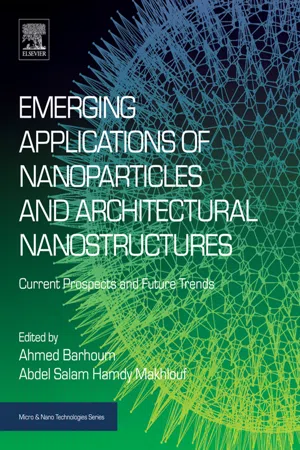
Emerging Applications of Nanoparticles and Architectural Nanostructures
Current Prospects and Future Trends
Abdel Salam Hamdy Makhlouf,Ahmed Barhoum
- 668 pagine
- English
- ePUB (disponibile sull'app)
- Disponibile su iOS e Android
Emerging Applications of Nanoparticles and Architectural Nanostructures
Current Prospects and Future Trends
Abdel Salam Hamdy Makhlouf,Ahmed Barhoum
Informazioni sul libro
Emerging Applications of Nanoparticles and Architecture Nanostructures: Current Prospects and Future Trends discusses the most important current applications of nanoparticles and architecture nanostructures in a comprehensive, detailed manner. The book covers major applications of nanoparticles and architecture nanostructures, taking into account their unusual shapes and high surface areas. In particular, coverage is given to applications in aerospace, automotive, batteries, sensors, smart textile design, energy conversion, color imaging, printing, computer chips, medical implants, pharmacy, cosmetics, and more. In addition, the book discusses the future of research in these areas.
This is a valuable reference for both materials scientists, chemical and mechanical engineers working both in R&D and academia who want to learn more on how nanoparticles and nanomaterials are commercially applied.
- Provides an in-depth look at the properties of nanoparticles and architecture nanostructures in terms of their applicability for industrial uses
- Analyzes the most recent advances and industrial applications of different types of nanoparticles and architecture nanostructures, taking into account their unusual structures and compositions
- Identifies novel nanometric particles and architectures that are of particular value for applications and the techniques required to use them effectively
Domande frequenti
Informazioni
Liquid-phase synthesis of nanoparticles and nanostructured materials
* UNAM-National Nanotechnology Research Center Bilkent University Ankara Turkey, Çankaya/Ankara, Turkey
** The Institute of Materials Science and Nanotechnology Bilkent University Ankara Turkey, Çankaya/Ankara, Turkey
† Queen Mary University of London, London, United Kingdom
‡ Vrije Universiteit Brussel (VUB), Brussels, Belgium
§ Helwan University, Helwan, Cairo, Egypt
Abstract
Keywords
1. Introduction
Indice dei contenuti
- Cover
- Title page
- Table of Contents
- Copyright
- List of Contributors
- About the Authors
- Chapter 1: Liquid-phase synthesis of nanoparticles and nanostructured materials
- Chapter 2: Functional nanostructured oxides: synthesis, properties, and applications
- Chapter 3: DNA nanostructures: chemistry, self-assembly, and applications
- Chapter 4: Ion-beam-assisted deposition of thin films
- Chapter 5: Risks and toxicity of nanoparticles and nanostructured materials
- Chapter 6: Nanoimprint lithography and transdermal drug-delivery devices
- Chapter 7: Noble metal nanoparticles: synthesis, and biomedical implementations
- Chapter 8: Laser deposition of nano coatings on biomedical implants
- Chapter 9: Physicochemical characterization of nanomaterials: polymorph, composition, wettability, and thermal stability
- Chapter 10: Physicochemical characterization of nanomaterials: size, morphology, optical, magnetic, and electrical properties
- Chapter 11: Engineered nanomaterials: nanofabrication and surface functionalization
- Chapter 12: Nanomaterials history, classification, unique properties, production and market
- Chapter 13: Recent progress on nanofabrication of molecularly imprinted polymers
- Chapter 14: Plant extract mediated synthesis of nanoparticles
- Chapter 15: Contemporary industrial practice for manufacturing of nanomedicines
- Chapter 16: Fabrication, functionalization, and dispersion of carbon nanotubes
- Chapter 17: Nanostructured thin films and nanocoatings
- Chapter 18: Bottom-up synthesis of hybrid carbon nanoscrolls
- Chapter 19: Synthesis of metal nanoparticles using laser ablation technique
- Chapter 20: Theories of nanoparticle and nanostructure formation in liquid phase
- Index